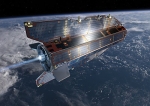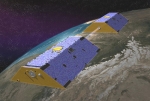Displaying items by tag: gravity
GOCE
A mission designed to measure the Earth's gravity field, launched on march 2009.
The Gravity Field and Steady-State Ocean Circulation Explorer (GOCE) is an ESA satellite that was launched on March 17, 2009. It is a satellite carrying a highly sensitive gravity gradiometer which detects fine density differences in the crust and oceans of the Earth.
GOCE data will have many uses, probing hazardous volcanic regions and bringing new insight into ocean behaviour. The latter, in particular, is a major driver for the mission. By combining the gravity data with information about sea surface height gathered by other satellite altimeters, scientists will be able to track the direction and speed of geostrophic ocean currents. The low orbit and high accuracy of the system will greatly improve the known accuracy and spatial resolution of the geoid (the theoretical surface of equal gravitational potential on the Earth).
The satellite's arrow shape and fins help keep the GOCE stable as it flies through the wisps of air still present at an altitude of 260 km. In addition, an ion propulsion system continuously compensates for the deceleration of air-drag without the vibration of a conventional chemically-powered rocket engine, thus restoring the path of the craft as closely as possible to a purely inertial trajectory. The craft's primary instrument is three pairs of highly sensitive accelerometers which measure gravitational gradients along three different axes.
GRACE
The Gravity Recovery And Climate Experiment (GRACE), a joint mission of NASA and the German Space Agency, has been making detailed measurements of Earth's gravity field since its launch in March 2002.
Gravity is determined by mass. By measuring gravity, GRACE shows how mass is distributed around the planet and how it varies over time. GRACE data are important tools for studying Earth's ocean, geology, and climate.
GRACE is a collaborative endeavor involving the Center for Space Research at the University of Texas, Austin; NASA's Jet Propulsion Laboratory, Pasadena, Calif.; the German Space Agency and Germany's National Research Center for Geosciences, Potsdam. The Jet Propulsion Laboratory is responsible for the overall mission management under the NASA ESSP program.
The principal investigator is Dr. Byron Tapley of the University of Texas Center for Space Research, and the co-principal investigator is Dr. Christoph Reigber of the GeoForschungsZentrum (GFZ) Potsdam.
The GRACE satellites were launched from Plesetsk Cosmodrome, Russia on a Rockot (SS-19 + Breeze upper stage) launch vehicle, on March 17, 2002.
GRAIL
GRAIL =Gravity Recovery and Interior Laboratory
The Gravity Recovery and Interior Laboratory (GRAIL) is an American lunar science mission in NASA's Discovery Program, which will use high-quality gravitational field mapping of the Moon to determine its interior structure. The two small spacecraft GRAIL A and GRAIL B were launched on 10 September 2011 aboard a single launch vehicle: the most-powerful configuration of a Delta II, the 7920H-10. GRAIL A separated from the rocket about nine minutes after launch, GRAIL B followed about eight minutes later. They will arrive at their orbits around the Moon 24 hours apart.
The science phase of the mission will last for 90 days. Following the science phase (or extended mission phase), a five-day decommissioning period is planned, after which the spacecraft will impact the lunar surface in about 40 days.[6] The gravity mapping technique is similar to that used by Gravity Recovery and Climate Experiment (GRACE), and the spacecraft design is based on XSS-11.
Unlike the Apollo program missions, which took three days to reach the Moon, GRAIL will make use of a three- to four-month low-energy trans-lunar cruise via the Sun-Earth Lagrange point L1 to reduce fuel requirements, protect instruments and reduce the velocity of the two spacecraft at lunar arrival to help achieve the extremely low 50 km (31 mi) orbits with separation between the spacecraft (arriving 24 hours apart) of 175 to 225 km (109 to 140 mi). The very tight tolerances in the flight plan leaves little room for error correction leading to a launch window lasting one second and providing only two launch opportunities per day.
The planned orbital insertion dates are December 31, 2011 (for GRAIL-A) and January 1, 2012 (for GRAIL-B).
NASA's Jet Propulsion Laboratory manages the project.
The GRAIL mission will place two spacecraft into the same orbit around the Moon. As they fly over areas of greater and lesser gravity, caused both by visible features such as mountains and craters and by masses hidden beneath the lunar surface, they will move slightly toward and away from each other. An instrument aboard each spacecraft will measure the changes in their relative velocity very precisely, and scientists will translate this information into a high-resolution map of the Moon's gravitational field.
This gravity-measuring technique is essentially the same as that of the Gravity Recovery And Climate Experiment (GRACE), which has been mapping Earth's gravity since 2002.
Objectives
GRAIL's engineering objectives are to enable the science objectives of mapping lunar gravity and using that information to increase understanding of the Moon's interior and thermal history. Getting the two spacecraft where they need to be, when they need to be there, requires an extremely challenging set of maneuvers never before carried out in solar system exploration missions. Mission design
The two GRAIL spacecraft will be launched together and then will fly similar but separate trajectories to the Moon after separation from the launch vehicle, taking about 3 to 4 months to get there. They will spend about 2 months reshaping and merging their orbits until one spacecraft is following the other in the same low-altitude, near-circular, near-polar orbit, and they begin formation-flying. The next 82 days will constitute the science phase, during which the spacecraft will map the Moon's gravitational field.
Spacecraft and payload
The two GRAIL spacecraft are near-twins, each about the size of a washing machine, with minor differences resulting from the need for one specific spacecraft (GRAIL-A) to follow the other (GRAIL-B) as they circle the Moon.
The science payload on each spacecraft is the Lunar Gravity Ranging System, which will measure changes in the distance between the two spacecraft down to a few microns -- about the diameter of a red blood cell. Each spacecraft will also carry a set of cameras for MoonKAM, marking the first time a NASA planetary mission has carried instruments expressly for an education and public outreach project.



